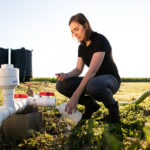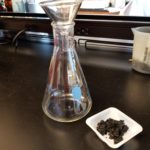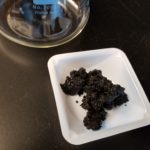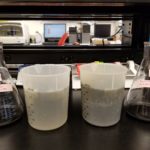Post submitted by Emily Martin, MS Environmental Science student at Iowa State University
Intensive farming and heavy nutrient application in the Midwest coupled with an extensive subsurface tile drainage network frequently leads to excessive nutrients in surface waters. As a result, heavy amounts of nitrogen and phosphorus has become a critical issue for policy and water research.
In spring 2017, I was awarded funding in the Iowa Water Center Graduate Student Supplemental Research Competition for my project titled, “Enhancing phosphate removal in woodchip bioreactors.” This project is conducted under advisement of Dr. Michelle Soupir at Iowa State University. A bioreactor is a subsurface trench along the edge of the field that can be filled with a range of different carbon sources. They are identified as a practice to help mitigate nutrient loss to flowing water systems, and so they deserve further research to understand their full capacity to capture water nutrients.
The goal of the project is to evaluate the ability of woodchip bioreactors to remove phosphorous by adding biochar as a phosphate (P) amendment to bioreactors. Objectives of the study are (1) to assess the effectiveness of different amendments on P removal in bioreactors and (2) to analyze the effect of influent P on overall removal.
We broke the project down into two main parts: a P sorption study and a column study. We completed part one during the month of June using 18 different types of biochar. The biochar was made by Bernardo Del Campo at ARTichar using three different temperatures of slow pyrolysis, 400°C, 600°C, and 800°C. We used six different types of biomass provided by the BioCentury Research Farm and the City of Ames, which are: switchgrass, corn stover, ash trees, red oak, mixed pine, and loblolly pine. The goal was to test a variety of biomass to see which would perform best as a P amendment and under which pyrolysis conditions they would function best.
Biochar is made using a process called pyrolysis. Pyrolysis is the burning of plant materials in a low to no oxygen chamber in order to “activate” the carbon structures that exists naturally within plants. The highly structured form of carbon rings in plants is desired for its stability and potential to adsorb or bind with chemicals, including phosphate and nitrate. There are two main types of pyrolysis: fast and slow, which refers to the amount of time the biomass remains in the pyrolysis chamber. Fast pyrolysis can be used to create biochar, but the yield is lower than slow pyrolysis. The temperature of pyrolysis can impact how the biochar interacts with different chemicals. In order to test these effects, we used three different temperatures when making our biochar.
Results from the P sorption study showed a few patterns. The main take away is that none of the biochars we tested adsorbed P exceptionally well; however, of the biochars we tested, the following were our top five P adsorbers:
- Corn stover @ 800°C
- Loblolly pine @ 600°C
- Red oak @ 600°C
- Switch grass @ 800°C
- Mixed pine @ 400°C
Because none of the biochars performed well in our P sorption test, we had to make a decision for the second part of the project. We came up with two options: (1) find new biomass and run the P sorption test again, or (2) test how well all 18 biochars remove nitrate from water. We chose option two and have begun nitrate batch tests, which will run throughout July. The batch tests are being run in one liter flasks and are tested at 4, 8, 12, and 24 hours to simulate woodchip bioreactor residence times found in the field.
After the nitrate batch test is complete, we will analyze results and decide if we will move forward with option one and see how other biomasses perform in a P sorption test.
Check back later on to learn more about the progress of this project!



